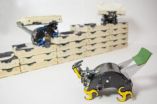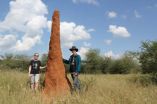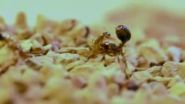(Press-News.org) Cambridge, Mass. – February 13, 2014 – On the plains of Namibia, millions of tiny termites are building a mound of soil—an 8-foot-tall "lung" for their underground nest. During a year of construction, many termites will live and die, wind and rain will erode the structure, and yet the colony's life-sustaining project will continue.
Inspired by the termites' resilience and collective intelligence, a team of computer scientists and engineers at the Harvard School of Engineering and Applied Sciences (SEAS) and the Wyss Institute for Biologically Inspired Engineering at Harvard University has created an autonomous robotic construction crew. The system needs no supervisor, no eye in the sky, and no communication: just simple robots—any number of robots—that cooperate by modifying their environment.
Harvard's TERMES system demonstrates that collective systems of robots can build complex, three-dimensional structures without the need for any central command or prescribed roles. The results of the four-year project were presented this week at the AAAS 2014 Annual Meeting and published in the February 14 issue of Science.
The TERMES robots can build towers, castles, and pyramids out of foam bricks, autonomously building themselves staircases to reach the higher levels and adding bricks wherever they are needed. In the future, similar robots could lay sandbags in advance of a flood, or perform simple construction tasks on Mars.
"The key inspiration we took from termites is the idea that you can do something really complicated as a group, without a supervisor, and secondly that you can do it without everybody discussing explicitly what's going on, but just by modifying the environment," says principal investigator Radhika Nagpal, Fred Kavli Professor of Computer Science at Harvard SEAS. She is also a core faculty member at the Wyss Institute, where she co-leads the Bioinspired Robotics platform.
Most human construction projects today are performed by trained workers in a hierarchical organization, explains lead author Justin Werfel, a staff scientist in bioinspired robotics at the Wyss Institute and a former SEAS postdoctoral fellow.
"Normally, at the beginning, you have a blueprint and a detailed plan of how to execute it, and the foreman goes out and directs his crew, supervising them as they do it," he says. "In insect colonies, it's not as if the queen is giving them all individual instructions. Each termite doesn't know what the others are doing or what the current overall state of the mound is."
Instead, termites rely on a concept known as stigmergy, a kind of implicit communication: they observe each others' changes to the environment and act accordingly. That is what Nagpal's team has designed the robots to do, with impressive results. Supplementary videos published with the Science paper show the robots cooperating to build several kinds of structures and even recovering from unexpected changes to the structures during construction.
Each robot executes its building process in parallel with others, but without knowing who else is working at the same time. If one robot breaks, or has to leave, it does not affect the others. This also means that the same instructions can be executed by five robots or five hundred. The TERMES system is an important proof of concept for scalable, distributed artificial intelligence.
Nagpal's Self-Organizing Systems Research Group specializes in distributed algorithms that allow very large groups of robots to act as a colony. Close connections between Harvard's computer scientists, electrical engineers, and biologists are key to her team's success. They created a swarm of friendly Kilobots a few years ago and are contributing artificial intelligence expertise to the ongoing RoboBees project, in collaboration with Harvard faculty members Robert J. Wood and Gu-Yeon Wei.
"When many agents get together—whether they're termites, bees, or robots—often some interesting, higher-level behavior emerges that you wouldn't predict from looking at the components by themselves," says Werfel. "Broadly speaking, we're interested in connecting what happens at the low level, with individual agent rules, to these emergent outcomes."
Coauthor Kirstin Petersen, a graduate student at Harvard SEAS with a fellowship from the Wyss Institute, spearheaded the design and construction of the TERMES robots and bricks. These robots can perform all the necessary tasks—carrying blocks, climbing the structure, attaching the blocks, and so on—with only four simple types of sensors and three actuators.
"We co-designed robots and bricks in an effort to make the system as minimalist and reliable as possible," Petersen says. "Not only does this help to make the system more robust; it also greatly simplifies the amount of computing required of the onboard processor. The idea is not just to reduce the number of small-scale errors, but more so to detect and correct them before they propagate into errors that can be fatal to the entire system."
In contrast to the TERMES system, it is currently more common for robotic systems to depend on a central controller. These systems typically rely on an "eye in the sky" that can see the whole process or on all of the robots being able to talk to each other frequently. These approaches can improve group efficiency and help the system recover from problems quickly, but as the numbers of robots and the size of their territory increase, these systems become harder to operate. In dangerous or remote environments, a central controller presents a single failure point that could bring down the whole system.
"It may be that in the end you want something in between the centralized and the decentralized system—but we've proven the extreme end of the scale: that it could be just like the termites," says Nagpal. "And from the termites' point of view, it's working out great."
INFORMATION:
This research was supported by the Wyss Institute for Biologically Inspired Engineering at Harvard University.
SIDEBARS
What can a TERMES robot do?
Move forward, backward, and turn in place
Climb up or down a step the height of one brick
Pick up a brick, carry it, and deposit it directly in front of itself
Detect other bricks and robots in immediate vicinity
Keep track of its own location with respect to a "seed" brick
What instructions do the TERMES robots follow?
Obey predetermined traffic rules
Circle the growing structure to find the first, "seed" brick (for orientation)
Climb onto the structure
Obtain a brick
Attach the brick at any vacant point that satisfies local geometric requirements
Climb off the structure
Repeat
Robotic construction crew needs no foreman
Self-organizing robots inspired by termite colonies demonstrate swarm-like intelligence
2014-02-14
ELSE PRESS RELEASES FROM THIS DATE:
'Sexy' underwear is not the only way to feel feminine on Valentine's Day, academic says
2014-02-14
AUDIO:
This is a Podcast recording of Dr. Christiana Tsaousi explaining her research.
Click here for more information.
TV makeover shows and glossy magazines can leave women feeling guilty for not wearing "sexy" lingerie – especially on Valentine's Day.
But in fact, many different types of underwear could make them feel feminine, according to an expert on underwear consumption.
Dr Christiana Tsaousi, a lecturer in marketing and consumption at the University of Leicester's ...
Study explores link between selling and leasing market prices for cars
2014-02-14
Changes in the selling prices of cars can be used to improve calculations for how much people should be paying to lease a vehicle, according to a new study.
Researchers from Norwich Business School at the University of East Anglia (UEA) and Athens University of Economics and Business (AUEB) have for the first time modelled the relationship between variations in leasing and selling market prices, using almost 10 years of data from the US, the world's largest automobile market. They suggest that in order to determine more accurately the monthly payments agreed in leasing ...
Cancer drugs hitch a ride on 'smart' gold nanoshells
2014-02-14
Nanoparticles capable of delivering drugs to specifically targeted cancer cells have been created by a group of researchers from China.
The multifunctional 'smart' gold nanoshells could lead to more effective cancer treatments by overcoming a major limitation of modern chemotherapy techniques—the ability to target cancer cells specifically and leave healthy cells untouched.
Small peptides situated on the surface of the nanoshells are the key to the improved targeting ability, guiding the nanoshells to specific cancer cells and attaching to markers on the surface of ...
First large-scale study of stock market volatility and mental disorders
2014-02-14
Falling stock prices lead to increased hospitalisations for mental disorders, according to new research published today in the journal Health Policy and Planning.
Researchers assessed the relationship between stock price movements and mental disorders using data on daily hospitalisations for mental disorders in Taiwan over 4,000 days between 1998 and 2009. They found that a 1000-point fall in the Taiwan Stock Exchange Capitalisation Weighted Stock Index (TAIEX) coincided with a 4.71% daily increase in hospitalisations for mental disorders.
A downward daily change in ...
Crazy ants dominate fire ants by neutralizing their venom
2014-02-14
VIDEO:
In this video, a fire ant dabs venom on an attacking crazy ant. The crazy ant coats itself with formic acid to neutralize the venom, a discovery made by University...
Click here for more information.
AUSTIN, Texas — Invasive "crazy ants" are rapidly displacing fire ants in areas across the southeastern U.S. by secreting a compound that neutralizes fire ant venom, according to a University of Texas at Austin study published this week in the journal Science Express. It's ...
Cat parasite found in western Arctic Beluga deemed infectious
2014-02-14
University of British Columbia scientists have found for the first time an infectious form of
the cat parasite Toxoplasma gondii in western Arctic Beluga, prompting a health advisory to the
Inuit people who eat whale meat.
The same team also discovered a new strain of the
parasite Sarcocystis, previously sequestered in the icy north, that is responsible for killing
406 grey seals in the north Atlantic in 2012.
Presenting their findings today at the 2014
Annual Meeting of the American Association for the Advancement of Science (AAAS), Michael Grigg
and ...
NOAA researcher says Arctic marine mammals are ecosystem sentinels
2014-02-14
As the Arctic continues to see dramatic declines in seasonal sea ice, warming temperatures and increased storminess, the responses of marine mammals can provide clues to how the ecosystem is responding to these physical drivers.
Seals, walruses and polar bears rely on seasonal sea ice for habitat and must adapt to the sudden loss of ice, while migratory species such as whales appear to be finding new prey, altering migration timing and moving to new habitats.
"Marine mammals can act as ecosystem sentinels because they respond to climate change through shifts in distribution, ...
Stanford psychologist shows why talking to kids really matters
2014-02-14
Fifty years of research has revealed the sad truth that the children of lower-income,
less-educated parents typically enter school with poorer language skills than their more
privileged counterparts. By some measures, 5-year-old children of lower socioeconomic status
(SES) score two years behind on standardized language development tests by the time they enter
school.
In recent years, Anne Fernald, a psychology professor at Stanford University, has
conducted experiments revealing that the language gap between rich and poor children emerges
during infancy. ...
For understanding family structure to trauma: New technology is yielding bigger data
2014-02-14
Austin - February 13, 2014 - Social media can do more than just entertain us and keep us connected. It also can help scientists better understand human behavior and social dynamics. The volume of data created through new technology and social media such as Facebook and Twitter is lending insight into everything from mapping modern family dynamics to predicting postpartum depression.
"By analyzing different types of social media, search terms, or even blogs, we are able to capture people's thinking, communication patterns, health, beliefs, prejudices, group behaviors – ...
Genetic chip will help salmon farmers breed better fish
2014-02-14
Atlantic salmon production could be boosted by a new technology that will help select the best fish for breeding.
The development will enable salmon breeders to improve the quality of their stock and its resistance to disease.
A chip loaded with hundreds of thousands of pieces of DNA – each holding a fragment of the salmon's genetic code – will allow breeders to detect fish with the best genes.
It does so by detecting variations in the genetic code of each individual fish – known as single nucleotide polymorphisms (SNPs). These variations make it possible to identify ...
LAST 30 PRESS RELEASES:
Tracing the quick synthesis of an industrially important catalyst
New software sheds light on cancer’s hidden genetic networks
UT Health San Antonio awarded $3 million in CPRIT grants to bolster cancer research and prevention efforts in South Texas
Third symposium spotlights global challenge of new contaminants in China’s fight against pollution
From straw to soil harmony: International team reveals how biochar supercharges carbon-smart farming
Myeloma: How AI is redrawing the map of cancer care
Manhattan E. Charurat, Ph.D., MHS invested as the Homer and Martha Gudelsky Distinguished Professor in Medicine at the University of Maryland School of Medicine
Insilico Medicine’s Pharma.AI Q4 Winter Launch Recap: Revolutionizing drug discovery with cutting-edge AI innovations, accelerating the path to pharmaceutical superintelligence
Nanoplastics have diet-dependent impacts on digestive system health
Brain neuron death occurs throughout life and increases with age, a natural human protein drug may halt neuron death in Alzheimer’s disease
SPIE and CLP announce the recipients of the 2025 Advanced Photonics Young Innovator Award
Lessons from the Caldor Fire’s Christmas Valley ‘Miracle’
Ant societies rose by trading individual protection for collective power
Research reveals how ancient viral DNA shapes early embryonic development
A molecular gatekeeper that controls protein synthesis
New ‘cloaking device’ concept to shield sensitive tech from magnetic fields
Researchers show impact of mountain building and climate change on alpine biodiversity
Study models the transition from Neanderthals to modern humans in Europe
University of Phoenix College of Doctoral Studies releases white paper on AI-driven skilling to reduce burnout and restore worker autonomy
AIs fail at the game of visual “telephone”
The levers for a sustainable food system
Potential changes in US homelessness by ending federal support for housing first programs
Vulnerability of large language models to prompt injection when providing medical advice
Researchers develop new system for high-energy-density, long-life, multi-electron transfer bromine-based flow batteries
Ending federal support for housing first programs could increase U.S. homelessness by 5% in one year, new JAMA study finds
New research uncovers molecular ‘safety switch’ shielding cancers from immune attack
Bacteria resisting viral infection can still sink carbon to ocean floor
Younger biological age may increase depression risk in older women during COVID-19
Bharat Innovates 2026 National Basecamp Showcases India’s Most Promising Deep-Tech Ventures
Here’s what determines whether your income level rises or falls
[Press-News.org] Robotic construction crew needs no foremanSelf-organizing robots inspired by termite colonies demonstrate swarm-like intelligence




